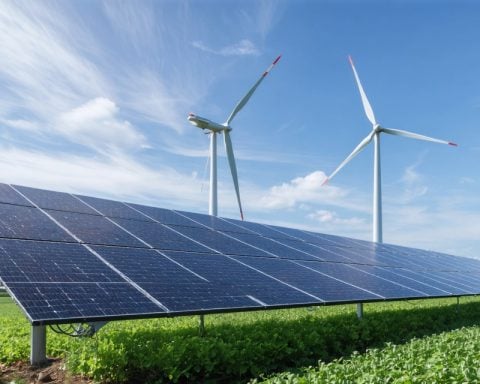As the world increasingly focuses on sustainability and energy efficiency, breakthroughs in thermal insulation materials are paving the way for a revolutionary future. Researchers and scientists are pushing the boundaries of what’s possible with innovations that promise to drastically reduce energy consumption and carbon footprints in construction and manufacturing.
The spotlight is on aerogels, often touted as the material of the future. These ultralight materials, composed predominantly of air, are making waves due to their superior insulating properties and remarkable strength. Unlike traditional insulation materials, aerogels offer the same thermal resistance with just a fraction of the thickness, making them an ideal choice for space-restricted applications.
But aerogels are just the beginning. Welcome to the world of phase change materials (PCMs), which absorb and release thermal energy during the process of melting and freezing, enhancing the thermal mass without extra weight. This ability to store and release heat positions PCMs as key players in maintaining optimal indoor temperatures, thereby cutting down the need for artificial heating and cooling.
Emerging technologies are also transforming waste into wonders. Eco-friendly insulation derived from recycled materials, such as denim, cotton, and even seaweed, showcases a commitment to reducing landfill waste while improving indoor air quality and thermal comfort.
As the demand for sustainable living environments grows, the advances in thermal insulation materials invite us to envision buildings metaphorically clad in smart fabrics, continuously adapting to our comfort while respecting the planet. The future of thermal insulation is not just a leap forward; it’s a step into a more efficient, sustainable world.
Revolutionizing Thermal Insulation: Key to a Sustainable Future
Thermal insulation materials are undergoing a transformative phase, offering a beacon of hope for a sustainable future. From ultralight aerogels to dynamic phase change materials and eco-friendly options derived from recycled waste, these innovations promise a significant impact across various sectors—chief among them, environmental sustainability and economic efficiency.
Impact on the Environment:
One of the primary environmental benefits of advanced thermal insulation materials is their potential to drastically reduce energy consumption. Buildings account for a substantial portion of global energy use, and enhancements in insulation can lead to decreased reliance on energy-intensive heating and cooling systems. Aerogels, with their superior thermal resistance despite minimal thickness, help maintain optimal temperatures indoors, which in turn lowers carbon emissions and the carbon footprint of the construction industry.
Contained within this spectrum of innovation are phase change materials (PCMs), which excel in energy management by absorbing, storing, and later releasing thermal energy. This capability allows structures to significantly reduce their energy needs for heating and cooling, thus lessening environmental impact and promoting more sustainable energy use. Furthermore, the development of eco-friendly insulation from recycled materials can contribute to waste reduction, cutting down on landfill contributions and promoting a circular economy.
Impact on the Economy:
The economic implications of these advancements are profound. As thermal insulation materials become more efficient and versatile, the costs associated with energy bills are likely to decrease for both residential and commercial sectors. This economic relief promotes financial sustainability for individual consumers and businesses alike. Additionally, the growth of sustainable practices and materials opens new markets and job opportunities in research, manufacturing, and installation, driving economic growth.
Future of Humanity:
The link between innovative thermal insulation and humanity’s future is both immediate and far-reaching. As cities continue to grow and the global population rises, the demand for energy-efficient and sustainable buildings becomes more urgent. By investing in cutting-edge materials, we are investing in a future that prioritizes human well-being and environmental health.
In summary, these breakthroughs hold the promise of transforming urban living into a model of energy efficiency and sustainability. This holistic vision can lead us forward into an era where human habitat design consciously interacts with the planet, ensuring that future generations inherit a world capable of supporting their needs. The industry’s commitment to these advanced insulation technologies not only heralds a more sustainable tomorrow but invites us to redefine our approach to living harmoniously with nature, paving a path towards thriving communities and a healthier planet.
Revolutionary Advancements in Thermal Insulation: The Future of Sustainable Architecture
As the global emphasis on sustainability intensifies, the realm of thermal insulation materials is witnessing groundbreaking innovations that promise to transform energy consumption and sustainability in construction. This article delves into cutting-edge advancements, exploring what makes these new materials pivotal in shaping eco-friendly architecture.
Key Innovations in Thermal Insulation
1. Aerogels: The Future of Insulation
Aerogels, known for their extraordinary insulating properties and minimal thickness, are gaining traction in various sectors. Comprising up to 99.8% air, these materials offer impressive thermal resistance and structural strength. Their unique composition makes them ideal for applications where space is a constraint, such as in aerospace and compact residential designs. For more on aerogels and their applications, visit Aerogel.
2. Phase Change Materials (PCMs): Energy Efficiency Redefined
Phase Change Materials are capable of absorbing and releasing thermal energy during phase transitions, which significantly enhances thermal mass. By maintaining optimal indoor temperatures, PCMs reduce dependence on artificial climate control systems. This not only conserves energy but also minimizes utility costs, contributing to sustainable building practices.
Sustainability and Environmental Impact
The shift towards eco-friendly insulation materials made from recyclable resources like denim, cotton, and seaweed is indicative of a broader commitment to sustainability. These materials not only decrease landfill waste but also boost indoor air quality and thermal comfort, thus aligning with environmental conservation goals.
Emerging Trends and Future Predictions
The demand for sustainable habitats is catalyzing trends in smart insulation technologies. Future buildings could function like “smart garments,” instantaneously adjusting to temperature changes while minimizing energy consumption. The trajectory of thermal insulation technology seems poised to align closely with advancements in smart home automation, further enhancing eco-friendly habitats.
Security and Compatibility
Security concerns regarding new insulation technologies often involve fire resistance and safety during installation. Most advanced materials, including aerogels and PCMs, are developed with these factors in mind, ensuring they meet stringent safety standards.
Furthermore, these materials are designed to harmonize seamlessly with existing architectural frameworks, making retrofitting older structures with modern insulation both feasible and effective.
Market Insights and Economic Considerations
The expanding interest in sustainable construction and energy efficiency has increased the market prospects for these advanced materials. Although the initial cost of integrating novel insulation solutions may be higher, the long-term economic benefits through energy savings and regulatory incentives offer a compelling case for widespread adoption.
Predictive analyses suggest a growing market share for thermal insulation materials, with aerogels and PCMs expected to capture major interest due to their efficiency and versatility.
Conclusion
As sustainable architecture gains momentum, the role of advanced thermal insulation materials like aerogels and PCMs becomes increasingly crucial. These innovations are not merely enhancements; they signify a monumental leap toward a future where construction and manufacturing are in harmony with environmental and energy efficiency goals. For further insights into the evolution of thermal insulation technologies, visit Green Building Advisor.












